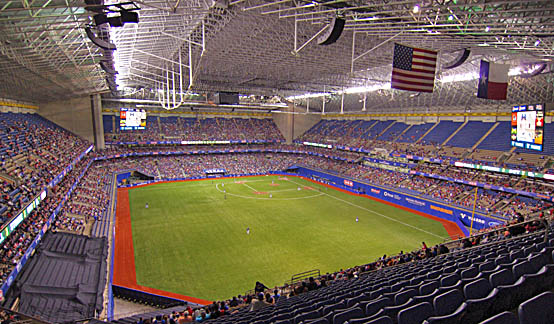 |
After NBA, Final Fours, concerts and NFL, baseball comes to San Antonio’s domed stadium
It was the building where the New Orleans Saints came to play after the Superdome was severely damaged by Katrina. NCAA’s Final Four — both for men’s basketball (three times) and women’s (two times) — has been a frequent visitor. A major college-football bowl game is played there each year, as is the country’s premier high-school football all-star game. The NBA played there for for nine season (including the championship series in 1999), and it was the site of the league’s All Star Game in 1996. It’s also seen soccer, rodeos, ice hockey and big concerts. In fact, it’s where George Strait elected to hold his farewell concert.
Yes, San Antonio’s Alamodome has hosted all kinds of major events in its 20-year history … but never baseball. That changed on March 29th and 30th of 2013. That’s when Ryan Sanders Baseball, owners of the Round Rock Express and Corpus Christi Hooks, put on an event called Big League Weekend. The Rangers (parent team of the Express) and Padres (parent of the local San Antonio Missions) squared off in two exhibition games just before the start of the regular season.
Was it a success? Before we answer that question, let’s take a look at what kind of baseball facility the Alamodome made.
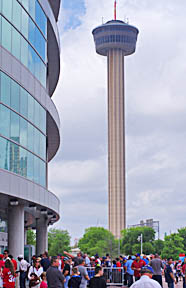 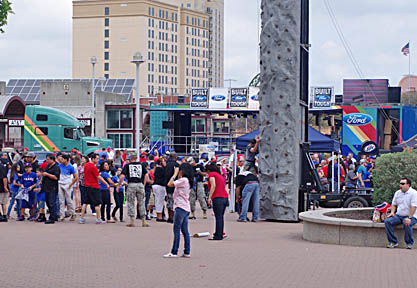 |
If you drive near downtown San Antonio, it’s virtually impossible to miss the Alamodome. The huge rectangular building features tall masts protruding skyward from each corner. These are used to support the roof/dome.
The building itself is on the east side of I-37 as it skirts by the main tourist area that contains the Alamo. Directly across the highway is the massive Tower of the Americas (above left) which is in Hemisphere Park.
The north-side plaza of the Alamodome is shown in both of the shots above. Prior to a sporting event here, the plaza is full of live music, attractions for kids and lots of people milling around. In the distance on the right-hand photo is a transit center, where park-and-ride buses and direct bus routes drop fans off. From a public transit perspective, the Alamodome was perfect for the two baseball games. From a parking perspective, it was simply inadequate. When the Spurs used to play basketball here, drawing well under 20,000 fans, the lots adjacent to stadium were probably sufficient. Now when a big event like Big League Weekend comes along, there simply isn’t enough parking next to the facility. And if you go online to buy a parking pass (like I did), the pass that has a face value of $20 (which is about what you’d expect) ballooned to almost $32 with the service charges tacked on. Pretty ridiculous.
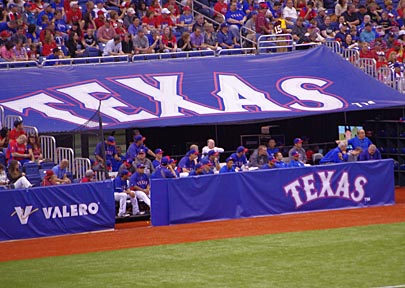 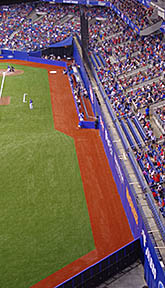 |
Once inside the Alamodome, it hits you pretty quickly what kind of compromises and accommodations had to be made to shoe-horn a baseball field in here. On the left, which is a close-up of the first-base side, you see the Rangers’ “dugout,” if you can call it that. The right-hand shot shows the foul territory on the third-base side. In order to have a dugout for the Padres there, a number of rows of seats had to be eliminated, putting the first row of seats about 15 feet above the level of the field. This was a clever way to allow as many fans as possible to see the plate and the base-path between third and home … although, as we will see, there were other complications that kept fans from being able to see.
The bullpens, by the way, were just beyond the outfield fence in left field.
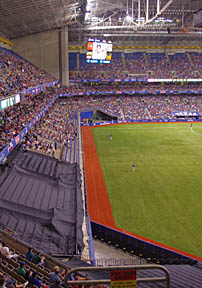 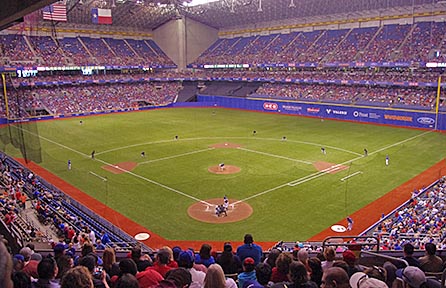 |
The shot on the left above was taken from high above center field, looking toward the right-field foul pole. The covered seats formed the batter’s eye. The seats beyond those tarps were 16 feet above the field, which was necessary to fit the outfield there. The distance to the RF foul pole was a short 285 feet as it was. The height of the wall was necessary to add to the distance needed to hit a home run, similar to the tall wall in right field at AT&T Park in San Francisco. Also, note how deep the center fielder and right fielder are playing in that picture. Any farther back and they’d be on the warning track.
The shot on the right was taken from the back of the Club Level looking out toward center field. It’s interesting to note that there were no more specators behind me, because I was standing in front of a huge corner of the building, just as it is in left center field in the photo on the right above. Also note in this photo that the lighting was uneven. I suppose it worked well when the Spurs played here because they didn’t use any of the space that was in LF or CF for this baseball game. Instead, the basketball court ran parallel to, and quite close to, the first-base foul line. Also, my guess is that football games probably didn’t suffer a lack of execution due to the uneven lighting either.
All things considered, Ryan Sanders Baseball did a great job working with the Alamodome people to be able to play baseball here at all. “We know the problems we had getting the field to fit into the stadium here,” Ryan Sanders CEO Reid Ryan told me. “There will never be a full-season baseball tenant here (in the Alamodome) because of that.” And Ryan’s company spent heavily to outfit the stadium to prepare it for the two baseball games. The artificial turf alone cost about a million dollars.
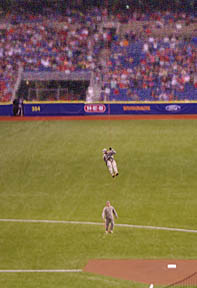 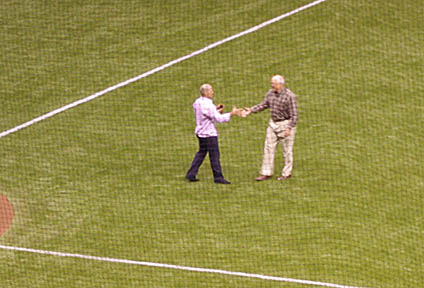 |
San Antonio is a city of lots and lots of military personnel, and they were honored at a number of different points throughout the weekend, as they should be. One clever way was to have two soldiers rappel from the ceiling rafters high above the field, carrying the baseball for the ceremonial first pitch of the game on Saturday March 30th. In the photo on the left, one of the soldiers is nearing the field below him as he climbed down a rope. On the right was the scene just following the ceremonial first pitch, where two Ranger legends formed the “battery.” Since a number of Ranger regulars were given the day off, sports writer Anthony Andro tweeted, “Who says there’s no starpower in the Rangers lineup today? Nolan Ryan throwing out first pitch to Pudge Rodriguez.” Nolan is the one on the right in the right-hand photo above.
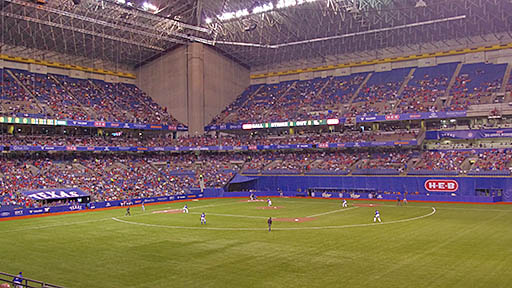 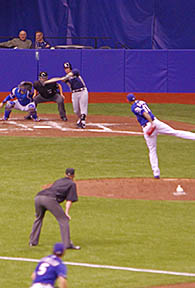 |
Above you see the very first pitch of the very first baseball game in the Alamodome. Ranger fireballer Alexi Ogando delivers the pitch to Everth Cabrera of the Padres.
How would the ball carry in the enclosed environment of the Alamodome? It took only two batters to answer that, as San Diego’s Will Venable, who has hit only 45 home runs in his 1,582 big-league at bats, rocketed the ball onto the batter’s eye in deep center field for a home run. Three innings later, Venable’s teammate Jedd Gyorko dropped a high fly ball into the right-field seats for a two-run homer (the swing is shown above right). The rookie from West Virginia would’ve seen the ball land in the right-fielder’s glove in any MLB park currently in use.
The Rangers came back to win the first of the two exhibitions 5-4. Texas followed that up with a 5-2 win the next day to sweep the two-game set.
  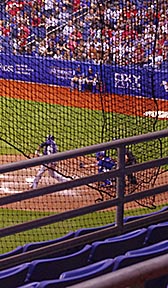 |
Perhaps the biggest complaint from fans dealt with the nets (above left) that hung from supports attached to the rafters (above center). Nowhere was this worse than behind the Padres “dugout” on the the third-base side, where fans were forced to look through one of two nets — or worse, to try to look through spots where two nets overlapped (right-hand photo above). Believe it or not, this is where my seats for the game on the 29th were located. Most of us in that section got up and moved to another place in the stadium, even if it was in the outfield looking in from far away. That’s where I went to watch much of the game.
“It all boils down to the fact that the glass at the front of the press box wasn’t bullet-proof,” Reid told me. “When the fire marshal examined the building, he asked about that glass, and we had to admit that it wasn’t bullet-proof. We were then required to install those nets that hang along the third-base foul line.” The infamous non-bullet-proof glass in front of the writers can be seen in the left-hand shot below.
Ryan went on to point out that “The seats on the third-base side (of the stadium) don’t have as good of a vantage point, with the nets and the way the seats start so high above the field. The other three sides of the stadium actually work pretty well. We had to sacrifice some of the view of the third-base side so the other three sides could see well.”
 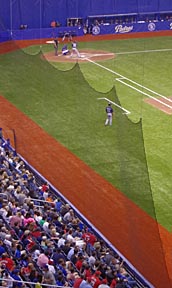 |
Another problem with the nets was along the first-base line, beyond the dugout (above right). At one point, I had a ticket on the front row, near the right-field corner. When I checked out the view, I immediately turned around and left to find somewhere else to sit. The problem? Trying to see the batter through the vast expanse of netting at an angle was practically impossible.
Granted, the areas where the visibility was the worst were fairly limited. Honestly, Ryan Sanders Baseball did an excellent job making the conditions as good as they could possibly be. And if you had the bad luck to have a seat where the netting was making it hard to see, it wasn’t hard to move to another section. Even with 35,000 or 40,000 at the games, there were still tens of thousands of unoccupied seats you could move to.
  |
On a lighter note, the contests and races between innings were quite enjoyable. Above, the “Ryan Express” mascot is beating other Texas “legends” Sam Houston, Davy Crockett and Jim Bowie. These characters typically race at Rangers’ home games in Arlington.
In a weekend of firsts at the Alamodome, quite a few signs like the one on the right-hand side above had to be posted for the first time around the stadium, since there had never been baseball here before.
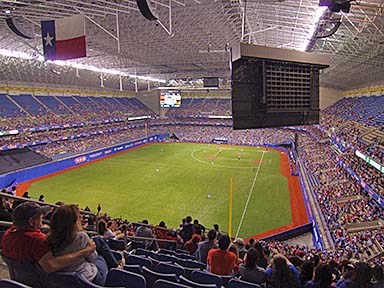  |
Was it worth all of the expense and trouble for Ryan Sanders Baseball to bring the first baseball games to the Alamodome? To me, the obvious answer is YES, as 75,000 fans bought tickets to see exhibition baseball played here. Selfishly, I’ll go anywhere to see big-time baseball played where it usually isn’t, and I know a number of ballpark enthusiasts traveled long distances to see the only baseball games ever played here.
But it goes beyond that. It was a smart strategic move for the Rangers, who are competing with the Astros for the very large San Antonio market. Houston is closer, but the Rangers have the far superior team right now — plus many more Ranger games are going to be televised in San Antonio this season than in the past, and it makes sense to get the locals excited about the boys from Arlington.
It made sense for the Padres, too. I’m sure they received a decent payday for playing these two exhibitions. In addition, the local Minor League team, the Missions of the Texas League, have the Padres as their Major League parent. Yes, Big League Weekend made sense on a lot of levels. And now that baseball has been played here, there’s one more reason to Remember The Alamodome.
If you attended one of these games, or you have thoughts on Big League Weekend, post your comments below. And if you want to learn more on this weekend, read Frank Jackson’s excellent write-up on the Hardball Times site. It provides a number of wonderful historical perspectives.